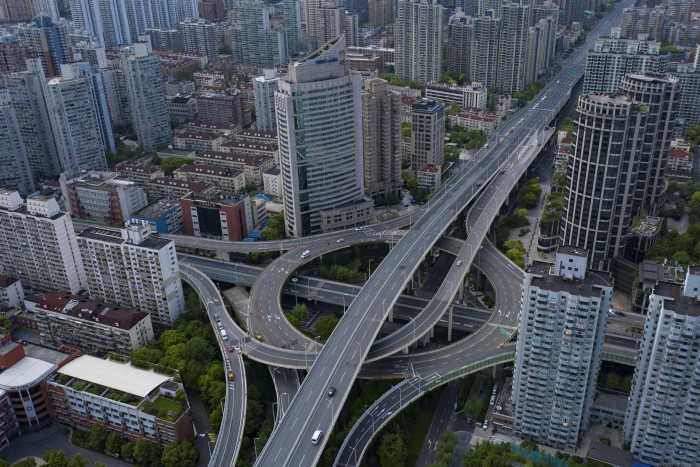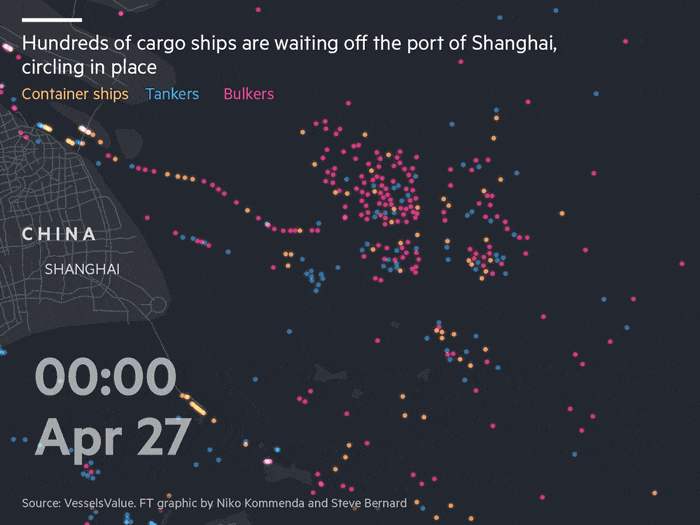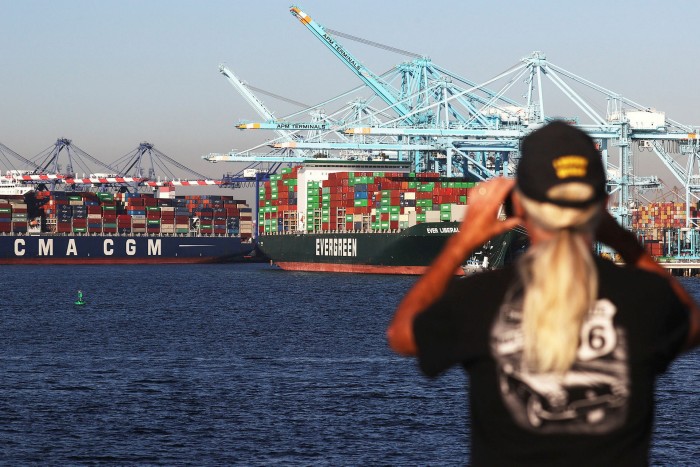[ad_1]
In early March truck drivers at Suto Logistics were ferrying 1,000 tonnes of goods every day in and out of Shanghai, China’s most important economic hub and the world’s busiest port. By the end of April, five weeks after local authorities had forced factories to close and residents to isolate in their homes, just one or two trucks were being dispatched daily, according to the company. And even they were no longer delivering their usual cargo of industrial materials, but “livelihood supplies” — groceries to sustain the city’s 26mn residents in their enforced isolation.
Suto is not alone in feeling the shock of Shanghai’s sudden lockdown, as authorities raced to contain an outbreak of the highly infectious coronavirus variant Omicron. The repercussions have rippled across the globe, with multinationals from Apple, Tesla and General Electric, to Amazon, Adidas and Estée Lauder warning of disruption to their supply chains due to the lockdown of a city that handles 20 per cent of China’s international trade.
Those warnings are likely to intensify if China digs its heels in and continues to pursue a zero-Covid policy that has left millions of workers across the country confined to their homes. President Xi Jinping, architect of the controversial policy, has vowed to crack down on criticism of it despite signs that the zero-Covid approach is damaging the economy.
Concern has been building since the port city of Shenzhen was closed briefly in March and Shanghai went into lockdown at the end of that month. Authorities have now imposed restrictions on Beijing, while the central Chinese city of Zhengzhou, a gateway for air freight, also limited the movement of people in May.
The rolling lockdowns are raising alarm bells at businesses that rely on raw materials, goods and components from China — home to seven of the world’s 10 biggest container ports, including Ningbo, Shenzhen and Guangzhou.

“In 2022 China is closing down again,” says Marie-Christine Lombard, chief executive of Geodis, the global transport and logistics provider owned by SNCF of France. “Our customers’ plants [in China] cannot work, their products cannot be produced. So it is pretty bad [ . . . ] first Shenzhen, then Shanghai and now Beijing. That creates anxiety in the minds of our customers.”
Joerg Wuttke, president of the EU Chamber of Commerce in China that represents about 1,000 businesses in the country, recently warned of “shortages on shelves in Europe at some stage [ . . .] we never had this kind of uncertainty before,” he said in early May. “It gets worse week by week. We don’t know [ . . .] where [restrictions] will pop up.”
Such disruptions to the global supply chain threaten to stoke the inflationary pressures exacerbated by Russia’s war on Ukraine. At the height of the upheaval caused by Covid-19 in 2020/2021, the rates paid for ocean and air freight soared to new highs. For example, rates for 40ft containers on routes from Shanghai to the west coast of the US nearly doubled during 2021 from $4,018 to $7,681, according to Shipping Intelligence Network. The IMF estimates that global freight increases alone added 1.5 percentage points to this year’s inflation forecasts.
Many in the transport and logistics sector remain hopeful that the worst can be avoided. But they are also aware that when China’s factories return to normal and sea freight starts moving again there is a risk that some European and US ports, plus infrastructure including land transport and warehousing, could be overwhelmed, adding more pressure to an already stretched global supply chain.
“We definitely see cargo still finding its way to Rotterdam,” says Hans Nagtegaal, director of containers at Europe’s biggest port. But “it’s becoming a little more complicated than normal. It tells me we are not out of the storm.”
‘We cannot find lorry drivers’
Chinese authorities, conscious of the country’s key role in the supply chain, have kept ports open, requiring workers to live on site in a so-called “closed-loop system”. Additionally, some cargo is being diverted to other Chinese ports such as Ningbo, 200km south of Shanghai, to allow shipments to continue.
Gene Seroka, executive director of the Port of Los Angeles, said at the start of May that those initiatives had helped to keep goods flowing. “Although conditions could change. I don’t see a bust coming anytime soon,” he told reporters. “The authorities in China, the port director himself, [are] making sure that transpacific trade and cargo specifically coming here to Southern California [are] prioritised.”
During the pandemic, soaring consumer appetite created serious disruption for a logistics chain based on just-in-time delivery, with little elasticity for unexpected demand. The Asia-to-US trade lane was all of a sudden “growing at double-digit volumes”, says Lombard of Geodis, “but there are only so many vessels.”

On the surface the current crisis might look like a rerun of the upheavals of 2020, which left the world short of everything from cars to bicycles. But in 2022 the situation is different, say experts, with China’s strict zero-Covid approach being the exception in Asia. Two years ago, many countries in Asia introduced tight Covid restrictions that hit production. But this time round “manufacturing in most Asian countries has restarted,” says Siew Loong Wong, president of Asia-Pacific at Kuehne+Nagel. “We should keep this in mind when assessing the overall impact on the global supply chain.”
Today, the logistics problem lies beyond the ports and airports, in inland China. Not only have factories shut, but the country’s patchwork system of regulations governing movement between towns and cities is making collection and delivery of cargo almost impossible.
“It is very hard for trucks to come into the city and leave without the right permit,” says one Shanghai-based shipping executive, who asked not to be named. “The problem is that permits issued by one place are not accepted universally.”
Drivers may be required to take Covid tests in one province that are not valid at the destination, so more testing is required. Permits to travel may not be recognised from one municipality to another, so containers have to be dropped off at borders — to be collected by a driver from another province. Or “drivers do not want to deliver to a restricted area because they worry they will not be able to come out again”, says Danny Lau, who owns an aluminium factory in Dongguan, near Shenzhen. His plant is struggling to deliver to customers. “We cannot find lorry drivers.”

Freightos, which operates an online freight marketplace, estimates that Shanghai has lost roughly 45 per cent of its trucking capacity since the end of March.
With no drivers to collect the goods, those factories that are still running are scrambling to get products to customers and costs are soaring. “We only have 20-30 per cent of [normal] transport capacity remaining,” says the manager of one Shanghai chemical plant. “Fees have increased almost fivefold. Prices fluctuate every day.”
The absence of drivers is also creating congestion at ports. With 90 per cent of global trade volumes moved by sea, terminals have to work smoothly to get goods to their destinations on time. But without drivers to collect containers, goods arriving at Chinese ports are sitting in terminals for much longer than normal.
In Shanghai, the average waiting time for import containers was 12.9 days on May 12, a 174 per cent increase on March 28, according to Project 44, the shipment tracker. Across the rest of China, the waiting time for export containers had increased 22 per cent by early May compared with March 12, says FourKites, another freight tracker.
As containers stack up, it is harder to load and unload vessels, which are then forced to wait in port for longer. By mid-April, the number of container ships waiting to unload at Chinese ports had doubled in less than two months, according to Windward, the maritime tracking platform.

The situation has eased somewhat, thanks to lower volumes coming in, but roughly 24 per cent of all container vessels queueing to unload globally were waiting outside Chinese ports at the end of last Thursday, says Windward. On average they were waiting 3.58 days, or 86 hours, against 115 hours in the first 12 days of April.
These delays have knock-on effects, meaning that vessels arrive late at ports in Rotterdam and Los Angeles, which have still not fully recovered from the disruptions of 2020/21. “When China [lockdowns] happened supply chains were [already] very backed up,” says Zvi Schreiber, chief executive of Freightos.
“Two years ago only about 20 per cent of vessels were being delayed,” says Rotterdam’s Nagtegaal. “Today that number is about 80 per cent.”
‘The quayside is only so large’
This volatility and uncertainty have become a way of life for many reliant on China for goods. Susanne Waidzunas, global supply chain operations manager for furniture retailer Ikea, says it now takes “50 per cent longer for us to send goods from our suppliers in China to our logistic units in the US and Europe”, due to port congestion and other supply chain bottlenecks. Shanghai’s lockdown “is just another disruption”, adds Waidzunas. “We have set ourselves up for it.”
Ikea is diverting goods from Shanghai to other ports, including Ningbo, using rail freight rather than trucks, and ordering earlier, she says. “We are operating in a volatile situation when it comes to demand and supply. We have learnt a lot in the past two years.”

That caution is echoed by Adam Lewis of digital customs broker Clear-It. “When we see an ETA for a ship coming in on May 2, we know that boat is probably not going to arrive for another two to three weeks. That’s been the name of the game for two years.”
Yet Nick Vyas, who runs the Kendrick Global Supply Chain Institute at the University of Southern California Marshall School of Business, warns that those two years of disruptions have “desensitised” western companies to the impact of China’s zero-Covid policy. Even if many order goods earlier than previously, sooner or later “we will be running out of things”, argues Vyas. “Ultimately the system has a finite capacity.”
That finite capacity could run into its limits when factories in China begin turning again. The worry is that the return to normal will coincide with peak season demand in the third quarter, and before current problems of port congestion and a scarcity of truck drivers are resolved.
“We expect an armada of vessels moving towards Europe again and that will have a bigger effect [than the Shanghai lockdown],” says Nagtegaal of Rotterdam port. “The quayside is only so large. It will move the logistical challenges from China towards Europe.”
Permits, pay talks and a return to ‘normal’
The decline in volumes from China could actually be a blessing in disguise, argue several industry executives. Data from FourKites shows that the 14-day average of shipment volumes travelling from China to the US was down 24 per cent as of May 6, having dipped as much as 36 per cent three weeks earlier. Roughly a third of deliveries to US customers have been delayed, down from 39 per cent at the end of April.
Mario Cordero, executive director of the Port of Long Beach, says the “chaos” caused to supply chains by the lockdowns has helped cut the backlog of container ships waiting to enter his port and the neighbouring Port of Los Angeles from more than 100 in January to 35 now.

West coast ports are waiting to see whether the slowdown in imports is followed by a surge in the coming months, once restrictions lift, he adds.
Seroka of the Port of Los Angeles, for example, is monitoring data from China on energy consumption, traffic patterns and pollution, to understand how busy the country’s factories are so it can prepare for the volumes of cargo to come. “I’m on the phone most evenings with friends . . . in Shanghai telling me what’s happening on the ground,” Seroka said.
Others fear that recently-launched contract talks between ports on the west coast of the US and unionised dockworkers could disrupt activity, as has happened in previous years, just as imports surge.
“If China kicks loose and starts sending those ships [ . . .] back at us we’re going see a really big surge,” Jim McKenna, chief executive of the Pacific Maritime Association, told reporters.
There are already signs that the blockages are beginning to ease. FourKites data shows that volumes were recovering and delays decreasing in the first week of May. Shanghai has pledged to ease restrictions by mid-May and there is evidence elsewhere that recovery can come quickly. Shenzhen’s Yantian port returned to normal within a month after coming out of lockdown in 2021, says Josh Brazil, vice-president of Project 44.
There are also indications that lessons have been learnt from the problems encountered in Shanghai. The government is urging local authorities to collaborate on permitting schemes to resolve the trucking crisis, says the Shanghai-based shipping executive.
Yet a return to normal will take time, says Rico Luman, senior economist on transport, logistics and automotive at ING Research. With more than 11 per cent of global container capacity stuck in ports, “stabilisation of the supply chain will take at least a couple of months after the end of the lockdowns. It takes time because everything is connected.” Container capacity is not expected to expand in a significant way before next year, he adds.
In Shanghai, some 2,000 factories have been authorised to resume production in recent weeks. But the conditions for a return to work remain complicated and difficult. “We still have to see if the workers are able to get to the factories,” says the Chinese shipping executive, who has spent nearly two months in some form of lockdown. “Public transport has stopped and a lot people don’t have cars.”
“I don’t think the situation will be dramatically changed until late May or early June,” the executive adds. “Shanghai can keep telling the world what it wants to accomplish, but others will have to play ball.”
Additional reporting by Wang Xueqiao in Shanghai
[ad_2]
Source link


